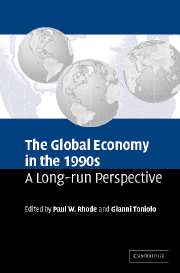Book contents
- Frontmatter
- Contents
- List of figures
- List of tables
- List of contributors
- Preface
- 1 Understanding the 1990s: a long-run perspective
- 2 The world economy in the 1990s: a long-run perspective
- 3 Managing the world economy in the 1990s
- 4 Europe: a continent in decline?
- 5 Technical change and US economic growth: the interwar period and the 1990s
- 6 General-purpose technologies: then and now
- 7 Productivity growth and the American labor market: the 1990s in historical perspective
- 8 The 1920s and the 1990s in mutual reflection
- 9 Bubbles and busts: the 1990s in the mirror of the 1920s
- 10 The 1990s as a postwar decade
- 11 What is happening to the welfare state?
- 12 The American economic policy environment of the 1990s: origins, consequences, and legacies
- References
- Author index
- Subject index
2 - The world economy in the 1990s: a long-run perspective
Published online by Cambridge University Press: 14 January 2010
- Frontmatter
- Contents
- List of figures
- List of tables
- List of contributors
- Preface
- 1 Understanding the 1990s: a long-run perspective
- 2 The world economy in the 1990s: a long-run perspective
- 3 Managing the world economy in the 1990s
- 4 Europe: a continent in decline?
- 5 Technical change and US economic growth: the interwar period and the 1990s
- 6 General-purpose technologies: then and now
- 7 Productivity growth and the American labor market: the 1990s in historical perspective
- 8 The 1920s and the 1990s in mutual reflection
- 9 Bubbles and busts: the 1990s in the mirror of the 1920s
- 10 The 1990s as a postwar decade
- 11 What is happening to the welfare state?
- 12 The American economic policy environment of the 1990s: origins, consequences, and legacies
- References
- Author index
- Subject index
Summary
Introduction
This chapter considers the 1990s in the context of long-run economic growth performance. Growth in the context of this chapter should be understood to comprise the growth of real living standards as well as real GDP per capita. There were a number of new experiences during the decade that were sufficiently surprising to warrant posing the question: “Do we now need to rethink the conventional wisdom about economic growth?”
The essential background to growth in the 1990s was the unprecedented extension and intensification of globalization in terms of the international integration of capital and product markets, sustained both by reductions in transport and communication costs and also by policy choices. Table 2.1 reports an increase in world merchandise exports relative to world GDP from 12.7 percent in 1990 to 18.8 percent in 2000, more than double the ratio reached before the disintegration of the world economy in the interwar years. Even more impressive has been the surge in international capital mobility, reflected in Table 2.1 through the ratio of assets owned by foreign residents to world GDP, which rose from 25.2 percent in 1980 to 48.6 percent in 1990, and further to 92.0 percent in 2000 – about five times the peak reached in the early twentieth century.
Obviously, this was facilitated by the more general adoption of policies of trade openness and financial liberalization. But technological progress also played an important role.
- Type
- Chapter
- Information
- The Global Economy in the 1990sA Long-Run Perspective, pp. 21 - 42Publisher: Cambridge University PressPrint publication year: 2006
- 3
- Cited by

